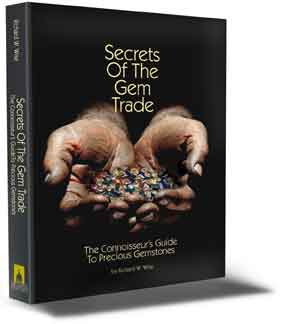New Auction Record For Natural Pearls:
The April 25th Christie’s sale followed a now familiar patter of jaw dropping, world record prices for large rare gem. Previous records for Burmese Rubies and Kashmir Sapphires have been smashed. The Baroda Pearls (image left), a double strand of 68 natural pearls that were formerly the property of the Gawkwar of Baroda was auctioned along with matching brooch, earrings and ring for the record sum of 7.1 million dollars. At this same sale a 22 carat Kashmir sapphire also set a world record (see previous post).
In the 19th century, the maharajah of Baroda, Khande Rao Gawkwar, came to possess the necklace that became known as the Baroda Pearls, The necklace was among the most expensive pieces in the Baroda Royal Treasury and remained one of its prized jewels throughout the 20th century.
The 825 square mile former principality of Baroda is located in northwestern India 148 miles north of Bombay. In 1907 Tiffany’s gemologist G. F. Kunz described the Baroda holdings as “among the greatest jeweled treasures of India” and estimated that the total value of pearls held by the Gawkwar to be 12 million dollars. The original “Baroda” necklace was composed of seven matched and graduated strands and was examined by Kunz and estimated by him to be worth a half a million dollars.
According to Christie’s the current necklace is composed of two large strands made of pearls from the fourth, fifth, sixth, and seventh strands of the original, joined by a cushion-cut Cartier diamond clasp. The 68 graduated pearls match in color, luster, and shape. The previous record for natural pearls at auction was set by Christie’s in Geneva in November 2004 at $3.1 million, for a two-strand natural pearl necklace.
Since about 1949, the natural pearl market was basically D.O.A (dead on arrival) though price lists like The Guide have continued to quote wholesale prices for natural pearls; there was essentially no market for natural pearls in the United States. Why, a combination of the Wall Street crash of 1929 and the emergence of the cultured pearl in the late 1920s. According to Elisabeth Strack author of Pearls the market fell by 85% in one day in 1930 when banks refused to accept pearls as collateral for loans to pearl dealers. I recall a conversation with David Federman in 2001 to the effect that this market was making a comeback.
Judging from at least one show in Tucson, the natural pearl is back. Several dealers featured natural pearls and natural pearl prices have experienced stratospheric price increases since the first record breaking auction sale in 2004. I had dinner with the Swiss dealer who brokered the Baroda Necklace. The next day he showed me a graduated double strand of white roundish natural pearls that he had on offer at 2 million dollars. According to this dealer the price of the strand had increased by a factor of ten over the past five years. Another savvy dealer, Jeremy Shepherd, President of Pearlparadise.com told me that the largest percentage increases have been in commercial grade natural pearls.
According to CIBJO rules a natural pearl is simply a “pearl” with no qualification required and the use of terms based on classic localities such as “oriental pearls” is also allowed.
Prices Up or Dollar Down in Las Vegas
As for prices for gems and jewelry, prices are up or as one dealer put it, prices are exactly the same for fine gems; the dollar has simply lost 35% of its value.
Interested in understanding more about the grading of fine pearls? Follow me on gem buying adventures in the pearl farms of Tahiti. Visit the gem fields of Australia and Brazil. 120 carefully selected photographs showing examples of the highest quality gems to educate the eye, including the Rockefeller Sapphire and many more of the world’s most famous gems. Consider my book: Secrets Of The Gem Trade, The Connoisseur’s Guide To Precious Gemstones.
educate the eye, including the Rockefeller Sapphire and many more of the world’s most famous gems. Consider my book: Secrets Of The Gem Trade, The Connoisseur’s Guide To Precious Gemstones.
“Wise is a renowned author… He’s
done a marvelous job of this first book, monumental work, a tour de force…My recommendation: Buy this book”.
Charles Lewton-Brain, Orchid
Only $39.95. Read a couple of chapters online: www.secretsofthegem
trade.com.
Buy it on Amazon: www.amazon.com




